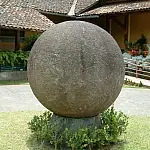A Brief History Of Teotihuacán, MexicoTeotihuacán is a large ancient city in Mexico dating to around 150 AD until the 6th century when it mysteriously fell into ruin.
Teotihuacán is a large ancient city located in what is now the San Juan municipality. It was the largest pre-Columbian city in the Americas during the first century AD and peaked between 150AD and 450AD where it dominated Mesoamerica with a population of between 150,000 and 250,000 people.
The name Teotihuacán is also used to refer to the civilisation and culture of the people that occupy this city. A common misconception is that Teotihuacán is an Aztec site. It was already in ruins before the commencement of the Aztec period.

Teotihuacán Meaning
Teotihuacán roughly means "place where gods were born" and it was also believed to be the location where the universe was created. There are various interpretations of the name, some of which include 'birthplace of the gods' and 'place of those who have the road of the gods'.
Teotihuacán Influence
The influence of Teotihuacán was spread throughout Mesoamerica where evidence of Teotihuacán presence can be seen at numerous sites in Veracruz and the Mayan civilisation. The stepped pyramids that were quite prominent in Maya and Aztec architecture came from Teotihuacán.
The city is known to be a centre of industry, home to many potters, jewellers and craftsmen. Teotihuacán is also known for producing obsidian artefacts. Unfortunately, there are no ancient Teotihuacan non-ideographic texts in existence, but there are inscriptions from Maya cities that show Teotihuacán nobility travelled to and perhaps conquered local rulers as far away as Honduras. Most of what we know about the culture at Teotihuacán comes from the murals that adorn the site and from hieroglyphic inscriptions made by the Maya describing their encounters with Teotihuacan conquerors.
Knowledge of the huge ruins of Teotihuacán was never lost, however. Throughout the ages after the fall of the city, squatters have lived on the site. During the Aztec times, the city was a place of pilgrimage and was identified with the myth of Tollan, the place where the sun was created. Teotihuacán also astonished the Spanish conquistadors during the Spanish Invasion in the sixteenth century. Today Teotihuacán is still one of the most noted archaeological attractions in Mexico.
Layout Map of Teotihuacán
The city of Teotihuacán is laid out on a grid, which is offset 15.5° from the cardinal points. The main road (Street of the Dead) runs from 15.5° east of north to 15.5° west of south, while its most impressive structure, the Pyramid of the Sun, is directly oriented to a point 15.5° north of west which is the exact position on the horizon at which the sun sets on August 13.

The setting of the Pyramid of the Moon at the far end of the Street of the Dead is also carefully aligned such that a line of sight goes directly over the top of the Pyramid of the Sun and marks the meridian, thus allowing the priests of the city to fix the times of noon and midnight with complete accuracy.
In 2003, a tunnel was discovered beneath the Feathered Serpent pyramid which has been undisturbed for 1,800 years. The sealed-off passage was found to contain thousands of extraordinary treasures lying exactly where they had first been placed as ritual offerings to the gods. Items unearthed included greenstone crocodile teeth, crystals shaped into eyes, and sculptures of jaguars ready to pounce. Even more remarkable was a miniature mountainous landscape, 17 metres underground, with tiny pools of liquid mercury representing lakes. The walls of the tunnel were found to have been carefully impregnated with powdered pyrite, or fool's gold, to give the effect, in the firelight, of standing under a galaxy of stars.
Human Sacrifice at Teotihuacán
Crafting wasn't the only thing concerning the city's Mesoamerican residents, as plenty of archaeological evidence points towards the fact that human and animal sacrifices were carried out here too.

Evidence of a grisly human sacrifice and a complex military infrastructure has emerged from an excavation of the ruins of the Pyramid of the Moon. A vault was discovered containing 12 bodies, ten of which had been decapitated, along with the remains of pumas, wolves and eagles.
Another tomb containing the remains of four men was found within the same layer of the pyramid in 2002. Isotopic analysis suggests two of the men buried there were Teotihuacans, while two were foreigners.
Physical evidence such as cut marks on the bones of ancient human skeletons had previously offered indirect proof of the practice of human sacrifice. Blood cells and fragments of muscle, tendon, skin and hair have been found on 2,000-year-old stone knives, with Mexican researchers calling it the first conclusive evidence pointing to the tool's use in human sacrifice.

Some knives were found to have more traces of red blood cells, while others had more skin, and others more muscle or collagen, which suggests that each cutting tool was used for a different purpose, according to its form. Researchers also found that the sacrificial knives were ritually deposited, unwashed, in special sites after being used.
Fall of Teotihuacán
Teotihuacán's downfall began around the 6th century, as environmental issues spiked a rise in early deaths. These problems came to a head in the 7th century, when many of the buildings associated with the ruling classes were methodically burned and ransacked, perhaps due to internal unrest.
Archaeologists continue to argue about the decline and fall of Teotihuacán. Did a marauding tribe sweep down from the north, driving civilian populations before them? Did the population rebel against the priesthood, corrupt in its power, or simply leave in a mass exodus?
There are no firm answers to these questions, but work on the site continues to produce important artefacts crafted by these people.












